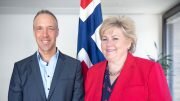The desert south of Oman resembles Mars so closely that over 200 researchers from 25 countries have chosen it as the base for testing new technology to be used on a manned mission to Mars.
The researchers will spend the next four weeks in the desert south of Oman, near the border with Yemen and Saudi Arabia. Few animals and plants manage to survive the conditions in the area, where temperatures can reach 51 degrees during the daytime.
‘The successful launch of SpaceX’s Falcon Heavy Rocket this week has led us to be in a completely different league, and we can start thinking about what we want to ship to Mars,’ said Kartik Kumar.
Inflatable
The researchers have created a ‘Mars base’ consisting of a huge 2.4 ton, inflatable
structure, surrounded by containers, which have been transformed into, among other things, several laboratories.
Radar, communication systems with ten-minute delays to simulate the delay between Earth and Mars, and newly developed vehicles, and a new generation of space ship are some of the things the researchers are testing.
The next step will be to deal with real issues like medical emergencies, and becoming
isolated on a foreign planet.
Optimism
The Oman government offered to host the AMADEE-18 project at a meeting of the UN Committee on the Peaceful Use of Outer Space (COPUOS). The project is headed by the Austrian Space Agency (OEWF).
Optimism is tangible
‘The first person to walk on Mars is already born. Perhaps they are currently in a classroom in Oman, or in Europe, in the USA, or China,’ said Joao Lousada, one of the participants in the mission.
© NTB Scanpix / Norway Today




